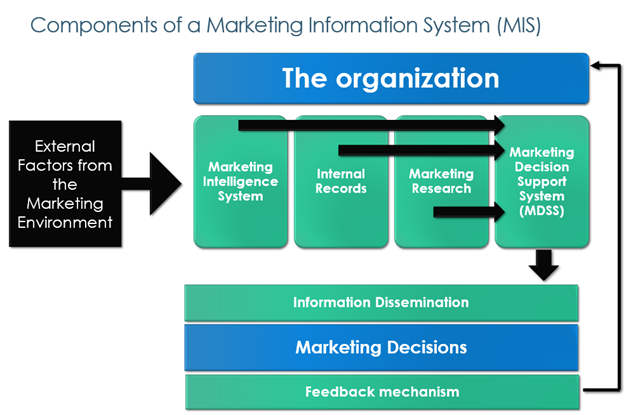Navigating with Data: Marketing Information Systems for Decision-Making
Marketing Information Systems
Effective decision-making requires quality information that is relevant, accurate, current, and impartial. To meet this need, organizations develop and use marketing information systems (MIS)[1].
What Is a MIS?
An MIS collects, analyzes, interprets, stores, and disseminates marketing data in an organized manner. The purpose of an MIS is to provide organizations with the accurate and timely information necessary to make informed marketing decisions.

The MIS collects and converts raw data into useful information that organizations can use to make informed decisions.
Data is raw, unorganized facts and figures without any context. Examples include numbers, symbols, text, or images. Data alone is not inherently meaningful.
Information is data that has been processed, organized, and given context, making it meaningful and useful for decision-making. Information provides insights and answers specific questions.
Key Components of MIS
MIS are made up of the following four components:
- Internal Records: Data generated within the organization that forms the foundation of an MIS. This data includes sales data, customer interactions, inventory levels, and financial information. These records offer insights into the company’s performance and help identify trends and opportunities for improvement.
- Marketing Intelligence System: Monitoring the environment in which the company operates to identify trends, opportunities, and threats. Some key marketing intelligence activities can include:
- Environmental Scanning: Continuously scanning the business environment to identify trends, opportunities, and competitive actions. This helps companies stay aware of changes in the market that could impact their strategies.
- Competitor Monitoring: Tracking competitors’ activities, such as pricing strategies, product launches, and promotional efforts. This allows companies to respond quickly to competitive threats or to capitalize on emerging opportunities.
- Market Awareness: A broader understanding of the market, including economic shifts, technological advancements, and changes in consumer behaviour. This helps companies adapt to external changes and stay relevant.
- Marketing Research: A systematic process of collecting, analyzing, and interpreting data to address specific marketing challenges or opportunities. This component provides deep insights into consumer behaviour, preferences, and market dynamics, helping businesses make informed decisions.
- Marketing Decision Support System (MDSS): A system that assists marketing managers in analyzing and interpreting data collected through internal records, marketing intelligence, and research. It includes tools for statistical analysis, modeling, and simulation. The MDSS aids in making data-driven decisions by providing analytical capabilities to evaluate different marketing scenarios.

Relevant information produced by the four components is then disseminated to stakeholders within the organization in a timely and actionable manner. By creating reports, dashboards, and communication tools, key findings and recommendations are shared with decision-makers. The MIS also has feedback mechanisms in place to evaluate the effectiveness of marketing strategies and activities, allowing for continuous improvement.
Example
The MIS Components for a Restaurant

- Internal Records:
- Sales Records: Restaurants can use point-of-sale (POS) systems to track daily sales, customer preferences, and peak dining times. This data helps in understanding which menu items are popular and when the restaurant experiences the most traffic, allowing for better inventory and staffing decisions.
- Inventory Management: By maintaining detailed records of inventory levels, restaurants can monitor stock usage and reduce waste. This system helps ensure that ingredients are available when needed and can alert managers to reorder supplies before they run out.
- Marketing Intelligence:
- Competitor Analysis: Restaurants can gather information about competitors by monitoring their menus, pricing strategies, and promotional activities. This intelligence helps in identifying market trends and adjusting the restaurant’s offerings to remain competitive.
- Customer Reviews and Feedback: Monitoring online reviews and social media mentions provides insights into customer satisfaction and areas for improvement. This feedback can guide service enhancements and menu adjustments.
- Marketing Research:
- Customer Surveys: Conducting surveys to gather feedback on customer experiences, preferences, and suggestions can provide insights into how the restaurant can improve its offerings and customer service.
- Focus Groups: Organizing focus groups with regular customers can help a restaurant understand customer expectations and test new menu items or service concepts before a full-scale launch.
- Marketing Decision Support System (MDSS):
- Predictive Analytics: Using data analytics tools to forecast customer demand and optimize menu pricing based on historical sales data and market trends. This helps in making informed decisions about menu adjustments and promotions.
- Scenario Analysis: Employing software to simulate different marketing strategies and their potential outcomes, allowing the restaurant to choose the most effective approach for increasing customer engagement and sales.
These components work together to provide a comprehensive view of the market environment, customer preferences, and operational efficiency, enabling restaurants to make informed decisions and enhance their competitive advantage
Now, for a closer look at marketing research…
Media Attributions
- Figure 1: “Banner Header Business People” by Gerd Altmann [geralt] (2015), via Pixabay, is used under the Pixabay content license.
- Figure 2: “Components of a marketing information system” [created using Microsoft PowerPoint] by the author is under a CC BY-NC-SA 4.0 license.
- Figure 3: “Restaurant, Kitchen, Chefs” by StockSnap (2017), via Pixabay, is used under the Pixabay content license.
- Harmon, R. R. (2002). Marketing information systems. Encyclopedia of Information Systems, 3, 137–151. https://doi.org/10.1016/B0-12-227240-4/00110-6 ↵
An organized framework for collecting, analyzing, interpreting, storing, and disseminating marketing data to support decision-making.
Raw, unorganized facts and figures without context, such as numbers, symbols, or text.
Data that has been processed and organized to provide meaning and insights for decision-making.
Data generated within an organization, such as sales data, customer interactions, and financial records.
A component of MIS used to monitor external environments for trends, opportunities, and threats.
The continuous monitoring of the business environment to identify trends, opportunities, and competitive actions.
A systematic process of collecting, analyzing, and interpreting data to address specific marketing challenges or opportunities.
Tools that assist marketing managers in analyzing data through statistical analysis, modeling, and simulations to make informed decisions.

